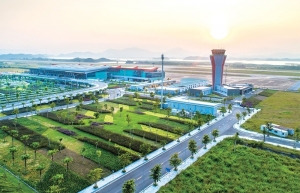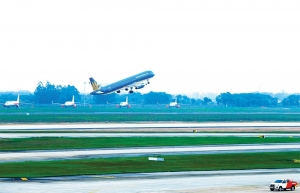Finding suitable models for small airports in Vietnam
NACO has over 70 years of airport planning and design experience and has delivered 600 airport projects worldwide. Our consulting and engineering firm has 6,000 employees and 30 offices worldwide, and has analysed the small airport model, international experiences, and recommendations for Vietnam.
 |
| Michel Werson, chief economist and lead of Financial Advisory at NACO – a subsidiary of Royal HaskoningDHV |
According to data sourced from our policy brief from 2019 about the sustainability of small airports, prepared by Airports Council International (ACI), there are almost 4,200 commercial airports with scheduled traffic worldwide.
In terms of throughput, we see that only 3 per cent of commercial airports handle more than 20 million annual passengers and 19 per cent handle between one and 20 million annual passengers. A total of 78 per cent of commercial airports handle less than a million passengers per year.
Together, these airports handle only 5 per cent of global traffic. So when looking at volume, small airports and airports with less than a million annual passengers play a very modest role in the aviation sector. Considering the commonly used rule of thumb that airports need at least one million annual passengers to be financially sustainable, it is tempting to conclude that small local airports have no importance or reason to exist.
Size is not everything
Even though a relatively small group of large airports dominate in terms of throughput, small and regional airports have an important function. We can think of the airport system in three layers. The top layer are the large hub airports with annual traffic volumes of more than 20 million passengers.
The lowest layer is made up of local airports with less than one million annual passengers. And the third layer is in-between, which connect both the hub airports and the local airports, and function as a direct feeder for large airports but also as a provider of strategic spare capacity capable of absorbing spill-over traffic.
But small airports bring other values. Small airports with more than one million annual passengers can – when managed properly – create direct economic value in terms of profits for the operators and investors. In addition, they create direct employment. And finally, they create indirect economic value: they attract investments and promote or support economic activities (such as tourism) and generate indirect employment and tax income for governments. Although each case is different, in general every million annual passengers creates about a thousand direct and indirect jobs.
The ACI report shows that most small airports are not operated stand-alone, but as part of a network. Of airports that handle less than one million passengers per year, 56 per cent are part of a network. Networks are either operated by a state or are corporatised. The latter are airports are part of a network entity that is not part of a ministry but has public shareholders. An example of this is the Schiphol Group. Besides Amsterdam Airport, Schiphol operates three regional airports in the Netherlands, and its shareholders are the Dutch state and two municipalities.
The rationale for that is that small airports benefit from a network. Firstly, network membership gives access to capital, something that many small standalones are typically struggling with. That makes it possible to keep facilities up to date, which helps to create a quality product and attract and retain airlines.
Furthermore, being part of a group helps to keep costs low through benefiting from joint procurement and shared services such as financial administration, human resources and IT systems management. It also gives access to best practices, expertise and contacts that would be too expensive when operating stand-alone. And finally, a maybe less obvious advantage is that within the group, economic performance can be compared with peers, which helps promote economic efficiency. Having looked at the airport network and the roles of airports of various sizes in the hierarchy, the question arises of what the optimal network looks like, how to plan for different airport sizes, where, and especially how close-by. Such nuances are considerations of the idea that airports, by definition, must be located far apart. Or that airports that are located close together are a waste of investment.
In many countries, the airport network historically grew and evolved over time, and the current network is only partly the result of a planning exercise. Looking at the presence of small airports worldwide, there is no easy generic formula that can define where airport capacity makes economic sense.
Each case needs to be analysed individually. There are situations where multiple airports can co-exist in proximity and where healthy competition contributes to creating a functioning equilibrium. And there are situations where this is not the case, and where – if you could plan anew – you would do it differently.
Private sector approaches
The potential benefits that private sector participation can bring to airport development and operations are clear. The growing number of airport concessions in various regions worldwide is a testimony to that.
Firstly, established companies bring along capital and a track record, which creates trust and makes lenders willing to provide capital. Next, private sector companies bring along management capabilities required for operational excellence and cost efficiencies, but to execute large and complicated capital programmes on time and within budget.
Markets with multiple airports can adopt various approaches involving the private sector. The first approach is to privatise the large airports and use the proceeds to sustain and invest in smaller ones. This approach can be considered when the small airports do not need much investment and/or have little potential. The disadvantage is that only the large airports benefit from private sector involvement.
A second approach is the opposite: bundling multiple small airports. Either because there are no large airports in the network or because large airports have another status or need to be retained under control for another reason. In this case, it is important that small airports are of sufficient size for the private operator.
A third approach is to create bundles or clusters that combine one or more larger airports with multiple small airports. This is probably the most common form. The advantage is that the smaller airports will be cross-subsidised by the larger ones. In such an approach, it is crucial to well-define any investment requirements for small airports. If not, the concessionaire might be tempted to only focus on the more profitable large airports in the bundle.
There are various ways governments can invite the private sector to participate in the development and operations of airports. There is no right and wrong way to do it. Considering the advantages that being part of a network brings, it makes sense to evaluate the possibility of privatising the development of smaller airports in a bundle. This creates economies of scale and scope.
 | PPPs driving small airport investment Vietnam wants to increase investment in domestic airports and establish better infrastructure, but capital will only increase when the institutional conditions are further improved. |
 | Capital sought for upgrade of airports Six airports, including five international ones, will shortly be handed over to local governments to actively solicit capital for upgrades. |
 | Small airports set to help local economies take off The development of small airports is believed to be crucial to boosting the potential of various regions and helping local economies to take off, a VIR roundtable heard on October 11. |
What the stars mean:
★ Poor ★ ★ Promising ★★★ Good ★★★★ Very good ★★★★★ Exceptional
Related Contents
Latest News
More News
- Vietnam ranks 38th in global AI adoption (January 14, 2026 | 16:01)
- European business confidence reaches highest in seven years (January 13, 2026 | 10:17)
- Vietnam’s regional influence draws renewed global attention (January 12, 2026 | 13:59)
- AI and digital twin centres launched in Hanoi (January 09, 2026 | 15:06)
- Vietnam leads ASEAN in EV market growth (January 09, 2026 | 14:39)
- AMC Robotics establishes Vietnam subsidiary to support robotics manufacturing (January 09, 2026 | 09:50)
- Major transport PPP projects open 2026 with strong investor interest (January 08, 2026 | 17:01)
- ONE and MTI launch AI-focused shipping venture (January 08, 2026 | 10:35)
- Market scale to be intensified through expansion of RCEP (January 08, 2026 | 10:09)
- Partnerships drive sustainable finance (January 07, 2026 | 09:23)

 Tag:
Tag:

















 Mobile Version
Mobile Version